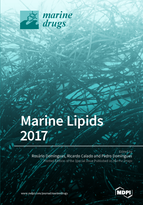Marine Lipids 2017
A special issue of Marine Drugs (ISSN 1660-3397).
Deadline for manuscript submissions: closed (31 August 2017) | Viewed by 59342
Special Issue Editors
Interests: lipidomics; oxidized lipids; nitrated/nitroxidized lipids; protein lipoxidation; Mass spectrometry; LC-MS
Special Issues, Collections and Topics in MDPI journals
Interests: fatty acids; LC-PUFA; marine invertebrates; DHA; marine biotechnology; marine aquaculture
Special Issues, Collections and Topics in MDPI journals
Interests: mass spectrometry; liquid chromatography-mass spectrometry; lipidomics; proteomics; oxidative stress
Special Issues, Collections and Topics in MDPI journals
Special Issue Information
Dear Colleagues,
Marine organisms are a well-known source of lipids with high nutritional value, such as n-3 fatty acids (e.g., 20:5 and 22:6), but also possess bioactive properties (e.g., polar lipids as glycolipids and phospholipids). Polar lipids are considered high added value bioactive molecules with health promoting effects, and with potential applications in food, feed, and pharmaceutical industries. Although some polar lipids of marine organisms are known to have functional properties (e.g., anti-inflammatory, anti-proliferative, antioxidant and antimicrobial), to potential of these molecules is yet to be fully unravelled, as the lipidome of the majority of marine organisms remains largely unknown. Different marine organisms, even when closely related in the tree of life, display specific lipidome signatures, which are representative of the remarkable chemical biodiversity present in world oceans. Lipid composition can also change due to environmental and nutritional conditions. If one considers that each marine organism contains thousands of structurally and functionally diverse lipids, it is clear that the characterization of their lipidome is a challenging task. Nonetheless, in recent years, advanced analytical approaches coupling chromatography and mass spectrometry emerged as powerful tools in lipidomic analysis. The resolution and high throughput analysis achieved with these analytical approaches has allowed researchers to identify and quantify the lipid species present on the cells and tissues of a diversity of marine organisms, opening new perspectives in the identification of lipid signatures for their valorisation and biotechnological applications.
This Special Issue, “Marine Lipids II, 2017”, will highlight innovative approaches and new findings on the lipidomics of marine organism, with emphasis on their valorization.
Dr. Rosário Domingues
Dr. Ricardo Calado
Dr. Pedro Domingues
Guest Editors
Manuscript Submission Information
Manuscripts should be submitted online at www.mdpi.com by registering and logging in to this website. Once you are registered, click here to go to the submission form. Manuscripts can be submitted until the deadline. All submissions that pass pre-check are peer-reviewed. Accepted papers will be published continuously in the journal (as soon as accepted) and will be listed together on the special issue website. Research articles, review articles as well as short communications are invited. For planned papers, a title and short abstract (about 100 words) can be sent to the Editorial Office for announcement on this website.
Submitted manuscripts should not have been published previously, nor be under consideration for publication elsewhere (except conference proceedings papers). All manuscripts are thoroughly refereed through a single-blind peer-review process. A guide for authors and other relevant information for submission of manuscripts is available on the Instructions for Authors page. Marine Drugs is an international peer-reviewed open access monthly journal published by MDPI.
Please visit the Instructions for Authors page before submitting a manuscript. The Article Processing Charge (APC) for publication in this open access journal is 2900 CHF (Swiss Francs). Submitted papers should be well formatted and use good English. Authors may use MDPI's English editing service prior to publication or during author revisions.
Keywords
- lipids
- lipidomics
- glycolipids
- phospholipids
- oxylipins
- fatty acids
- marine organisms
- bioactivity








